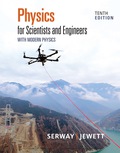
Concept explainers
Over the Christmas break, you are making some extra money for buying presents by working in a factory, helping to move crates around. At one particular time, you find that all the handtrucks, dollies, and carts are in use, so you must move a crate across the room a straight-line distance of 35.0 m without the assistance of these devices. You notice that the crate has a rope attached to the middle of one of its vertical faces. You decide to move the crate by pulling on the rope. The crate has a mass of 130 kg, and the coefficient of kinetic friction between the crate and the concrete floor is 0.350. (a) Determine the angle relative to the horizontal at which you should pull upward on the rope so that you can move the crate over the desired distance with the force of the smallest magnitude. (b) At this angle of pulling on the rope, how much work do you do in dragging the crate over the desired distanced?
Trending nowThis is a popular solution!

Chapter 7 Solutions
Physics for Scientists and Engineers with Modern Physics
- Make sure to draw a sketch with scalearrow_forwardUltimate Byleth and Little Mac fight. Little Mac, who is a boxer, dashes forward at 26.6 m/s, fist first. Byleth moves in the opposite direction at 3.79 m/s, where they collide with Little Mac’s fist. After the punch Byleth flies backwards at 11.1 m/s. How fast, and in what direction, is Little Mac now moving? Little Mac has a mass of 48.5 kg and Byleth has a mass of 72.0 kg.arrow_forwardMake sure to draw a sketch with scale as wellarrow_forward
- Make sure to draw a sketch with scale pleasearrow_forwardKirby jumps towards his enemy/ally, Meta Knight, at 2.06 m/s while Meta Knight glides in the opposite direction (toward Kirby) at 5.06 m/s. Kirby then begins to inhale, swallowing Meta Knight. What is Kirby/Meta Knight’s velocity immediately after being swallowed? Please put the magnitude of the velocity and then mark direction using dropdown menu. Kirby has a mass of 0.283 kg and Meta Knight has a mass of 0.538 kg.arrow_forwardNo Aiarrow_forward
- Can someone help mearrow_forwardNeed help on the following questions on biomechanics. (Please refer to images below)A gymnast weighing 68 kg attempts a handstand using only one arm. He plants his handat an angle resulting in the reaction force shown.A) Find the resultant force (acting on the Center of Mass)B) Find the resultant moment (acting on the Center of Mass)C) Draw the resultant force and moment about the center of mass on the figure below. Will the gymnast rotate, translate, or both? And in which direction?arrow_forwardPlease help me on the following question (Please refer to image below)An Olympic lifter (m = 103kg) is holding a lift with a mass of 350 kg. The barexerts a purely vertical force that is equally distributed between both hands. Each arm has amass of 9 kg, are 0.8m long and form a 40° angle with the horizontal. The CoM for each armis 0.5 m from hand. Assuming the lifter is facing us in the diagram below, his right deltoidinserts 14cm from the shoulder at an angle of 13° counter-clockwise from the humerus.A) You are interested in calculating the force in the right deltoid. Draw a free body diagramof the right arm including the external forces, joint reaction forces, a coordinate system andstate your assumptions.B) Find the force exerted by the right deltoidC) Find the shoulder joint contact force. Report your answer using the magnitude and directionof the shoulder force vector.arrow_forward
 Glencoe Physics: Principles and Problems, Student...PhysicsISBN:9780078807213Author:Paul W. ZitzewitzPublisher:Glencoe/McGraw-Hill
Glencoe Physics: Principles and Problems, Student...PhysicsISBN:9780078807213Author:Paul W. ZitzewitzPublisher:Glencoe/McGraw-Hill Physics for Scientists and Engineers: Foundations...PhysicsISBN:9781133939146Author:Katz, Debora M.Publisher:Cengage Learning
Physics for Scientists and Engineers: Foundations...PhysicsISBN:9781133939146Author:Katz, Debora M.Publisher:Cengage Learning Physics for Scientists and EngineersPhysicsISBN:9781337553278Author:Raymond A. Serway, John W. JewettPublisher:Cengage Learning
Physics for Scientists and EngineersPhysicsISBN:9781337553278Author:Raymond A. Serway, John W. JewettPublisher:Cengage Learning Physics for Scientists and Engineers with Modern ...PhysicsISBN:9781337553292Author:Raymond A. Serway, John W. JewettPublisher:Cengage Learning
Physics for Scientists and Engineers with Modern ...PhysicsISBN:9781337553292Author:Raymond A. Serway, John W. JewettPublisher:Cengage Learning Principles of Physics: A Calculus-Based TextPhysicsISBN:9781133104261Author:Raymond A. Serway, John W. JewettPublisher:Cengage Learning
Principles of Physics: A Calculus-Based TextPhysicsISBN:9781133104261Author:Raymond A. Serway, John W. JewettPublisher:Cengage Learning Physics for Scientists and Engineers, Technology ...PhysicsISBN:9781305116399Author:Raymond A. Serway, John W. JewettPublisher:Cengage Learning
Physics for Scientists and Engineers, Technology ...PhysicsISBN:9781305116399Author:Raymond A. Serway, John W. JewettPublisher:Cengage Learning





